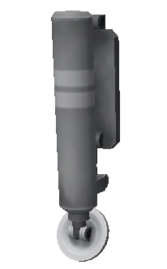LT-1 Landing Struts
| LT-1 Landing Struts | ||
| Landing leg by Moving Parts Experts Group | ||
| Radial size | Radial mounted | |
| Cost | (total) | 440.00 |
| Mass | (total) | 0.050 t |
| Drag | 0.2 | |
| Max. Temp. | 2000 K | |
| Impact Tolerance | 12 m/s | |
| Research | | |
| Unlock cost | 2 900 | |
| Since version | 0.16 | |
| Part configuration | landingLegLT-1.cfg | |
| Retractable | Yes | |
| Brake torque | No | |
| Steering range | No | |
| Packed volume | 160 l | |
The LT-1 Landing Strut is used as a landing support when landing vertically.
Contents
Usage
The LT-1 is connected radially and extends with the G key (default). It does not extend as far as the larger LT-2 Landing Strut, but is half as heavy.
As they are relatively short, LT-1 landing struts need to be placed low on a rocket. They do not extend far enough to be used with LV-T30, LV-T45, or the Poodle, but can reach past the LV-909 and Aerospike. A workaround with larger engines is using girders, I-beams, or panels to extend lower on the craft with a landing strut on each to contact the ground.
The maximum safe landing speed for an LT-1 landing strut is ~12 m/s. Landings with massive rockets or on rough terrain may need to be slower to avoid ripping off landing legs.
Each LT-1 leg can barely support 15 tons in Kerbin's gravity when sitting still. Each leg can absorb a gentle landing impact for a 3 ton load.
Tuning
There are two settings for the landing leg: spring and damper. It depends on the gravity of the landing site, but also on the mass of the ship.
- Spring increases the mass the legs can support.
- Damper counters bounciness from spring decompressing. Higher settings make the spring more sluggish to react, which diminishes the effect of small impacts or oscillations and keeping the craft stable.
Due to this:
- Having a spring setting that's too low has the risk of reaching the "end of travel" (i.e. trying to compress too far) when landing, if your landing's not gentle enough. It can also mean that your ship may wobble around when on the ground and thus lean over, as the spring cannot support the ship's weight.
- Having a damper setting that's too low means that things bounce and oscillate.
In general, to prevent a ship bouncing around, set the damper higher than springs, maybe even crank up damper strength.
Product description
| “ | It may have been originally designed as a heavy-duty metal detector, but this landing leg certainly emphasises an important fact in surface landings: you don't need to put a crater in the ground to stop yourself! — Moving Parts Experts Group |
” |
Changes
- Moved from Utility to Ground
- Added deployment sounds
- Revamped (new model), new deployment animation and Suspension
- Name corrected (LT-2 → LT-1), mass increased from 0.005 to 0.05.
- part file/internal behavior changed.
- Initial release

